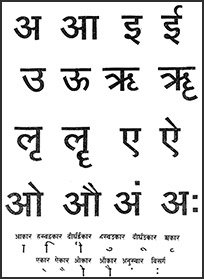Khac: 9 definitions
Introduction:
Khac means something in Hinduism, Sanskrit. If you want to know the exact meaning, history, etymology or English translation of this term then check out the descriptions on this page. Add your comment or reference to a book if you want to contribute to this summary article.
Alternative spellings of this word include Khach.
In Hinduism
Vyakarana (Sanskrit grammar)
Source: Wikisource: A dictionary of Sanskrit grammarKhac (खच्).—Kṛt affix अ (a) in the sense of 'agent' applied to the roots वद्, ताप् (vad, tāp), and यम् (yam) when preceded by certain उपपद (upapada) words standing as objects. Before this affix खच् (khac), the augment मुम् (mum) (म् (m)) is added to the preceding उपपद (upapada) if it is not an indeclinable. e. g. प्रियंवदः, वशंवदः, द्विषंतपः परंतपः वाचंयमः (priyaṃvadaḥ, vaśaṃvadaḥ, dviṣaṃtapaḥ paraṃtapaḥ vācaṃyamaḥ) etc. cf P.III. 2.38-47.

Vyakarana (व्याकरण, vyākaraṇa) refers to Sanskrit grammar and represents one of the six additional sciences (vedanga) to be studied along with the Vedas. Vyakarana concerns itself with the rules of Sanskrit grammar and linguistic analysis in order to establish the correct context of words and sentences.
Languages of India and abroad
Sanskrit dictionary
Source: DDSA: The practical Sanskrit-English dictionaryKhac (खच्).—I. 1, 9 P. [खचति, खच्नाति, खचित (khacati, khacnāti, khacita))
1) To come forth, appear.
2) To be born again.
3) To purify. -II. 1 U. (khacayati, khacita)
1) To fasten, bind.
2) To set, inlay.
Source: Cologne Digital Sanskrit Dictionaries: Shabda-Sagara Sanskrit-English DictionaryKhac (खच्).—[khaca] r. 1st cl. (khacati) also r. 9th cl. (khacnāti) 1. To be past birth. 2. To cause prosperity. 3. To purify. r. 10th cl. (khacayati) To fasten, to bind, to set.
Source: Cologne Digital Sanskrit Dictionaries: Benfey Sanskrit-English DictionaryKhac (खच्).— (probably for kṣac; cf. khañj and [Latin] scatere), i. 1 (and † ii. 9), [Parasmaipada.] 1. To spring up, [Kathāsaritsāgara, (ed. Brockhaus.)] 23, 88. 2. To appear, [Lassen, Anthologia Sanskritica.] 73, 13. 3. † To bind. khacita, 1. Crowded, [Śākuntala, (ed. Böhtlingk.)] [distich] 170, v. r. 2. Inlaid, [Meghadūta, (ed. Gildemeister.)] 36.
— With the prep. ud ud, utkhacita, Mixed, [Raghuvaṃśa, (ed. Stenzler.)] 13, 54.
Source: Cologne Digital Sanskrit Dictionaries: Cappeller Sanskrit-English DictionaryKhac (खच्).—khacati [participle] khacant glimmering, shining, & khacita q.v. — Cf. utkhacita & parikhacita.
Source: Cologne Digital Sanskrit Dictionaries: Monier-Williams Sanskrit-English DictionaryKhac (खच्):—[class] 1. [Parasmaipada] cati (only [past participle] cat), to come forth, project (as teeth), [Kathāsaritsāgara xxiii];—xxvi: [class] 9. [Parasmaipada] khacñāti, to be born again, [Dhātupāṭha xxxi, 59];
—to cause prosperity, [ib.];
—to purify, [ib.] : [class] 10. [Parasmaipada] khacayati, to fasten, bind, [ib. xxxv, 84.]
Source: DDSA: Paia-sadda-mahannavo; a comprehensive Prakrit Hindi dictionary (S)Khac (खच्) in the Sanskrit language is related to the Prakrit words: Khaca, Veaḍa.
[Sanskrit to German]
Sanskrit, also spelled संस्कृतम् (saṃskṛtam), is an ancient language of India commonly seen as the grandmother of the Indo-European language family (even English!). Closely allied with Prakrit and Pali, Sanskrit is more exhaustive in both grammar and terms and has the most extensive collection of literature in the world, greatly surpassing its sister-languages Greek and Latin.
See also (Relevant definitions)
Starts with (+41): Khaca, Khacaakhaca, Khacaka, Khacakhaca, Khacakka, Khacakkane, Khacakra, Khacalanem, Khacamaca, Khacamasa, Khacana, Khacanem, Khacara, Khacaramgane, Khacarana, Khacaranayaka, Khacarapati, Khacarapluta, Khacarata, Khacaratana.
Ends with: Utkhac.
Full-text (+65): Khav, Khacita, Bhujanga, Utkhac, Khacati, Utkhacita, Parikhacita, Khaca, Veada, Nabhasangama, Balindama, Vasundhara, Ravinda, Arimdama, Uranga, Ratrimmanya, Shatruntapa, Arindama, Meghankara, Sarvandama.
Relevant text
Search found 2 books and stories containing Khac; (plurals include: Khacs). You can also click to the full overview containing English textual excerpts. Below are direct links for the most relevant articles:
Vietnamese Buddhist Art (by Nguyen Ngoc Vinh)
1. History of Champa < [Chapter 2 - Similarity of Buddhist monuments in South Vietnam and South East Asia]
Philosophy of language in the Five Nikayas (by K.T.S. Sarao)